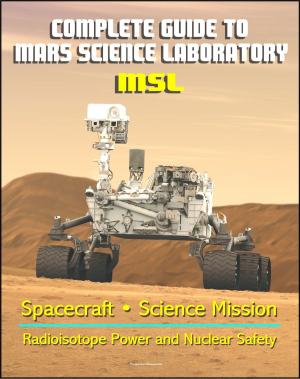International Space Station (ISS) Systems Engineering Case Study: History and Development of the Station, Hardware and Software, Anomaly Resolution, Russian Participation
Nonfiction, Science & Nature, Technology, Aeronautics & Astronautics, Science, Physics, Astrophysics & Space Science| Author: | Progressive Management | ISBN: | 9781476168883 |
| Publisher: | Progressive Management | Publication: | July 18, 2012 |
| Imprint: | Smashwords Edition | Language: | English |
| Author: | Progressive Management |
| ISBN: | 9781476168883 |
| Publisher: | Progressive Management |
| Publication: | July 18, 2012 |
| Imprint: | Smashwords Edition |
| Language: | English |
This case study on the International Space Station considers what many believe to have been the ultimate international engineering project in history. The initial plans involved the direct participation of 16 nations, 88 launches and over 160 spacewalks—more space activities than NASA had accomplished prior to the 1993 International Space Station decision. Probably more important was the significant leap in System Engineering (SE) execution that would be required to build and operate a multi-national space station. In a short period of time, NASA and its partners had to work out how to integrate culturally different SE approaches, designs, languages and operational perspectives on risk and safety.
The International Council on Systems Engineering (INCOSE) defines Systems Engineering (SE) as an "interdisciplinary approach and means to enable the realization of successful systems. It focuses on defining customer needs and required functionality early in the development cycle, documenting requirements, and then proceeding with design synthesis and system validation while considering the complete problem: operations, performance, test, manufacturing, cost and schedule, training and support, and disposal."
One of the objectives of the Air Force Center for Systems Engineering (AFCSE) is to develop case studies focusing on the application of systems engineering principles within various aerospace programs. The intent of these case studies is to examine a broad spectrum of program types and a variety of learning principles using the Friedman-Sage Framework to guide overall analysis.
These cases support practitioners of systems engineering and are also used in the academic instruction in systems engineering within military service academies and at both civilian and military graduate schools.
SYSTEMS ENGINEERING PRINCIPLES * General Systems Engineering Process * Case Studies * Framework for Analysis * ISS Major Learning Principles and Friedman-Sage Matrix * Historical Background * Soviet Space Stations * Skylab * Space Station Freedom * Shuttle-Mir Program * Space Station Freedom Redesign * Budget * Studies/Review Panels * Changes from SSF to ISS * NASA Systems Engineering Environment * NASA Management Approach * NASA Center Approaches * System Engineers and the Experience Chain * Systems Engineering Challenges of the ISS * Systems Engineering Process * International Partners * Safety/Risk approaches * FULL SCALE DEVELOPMENT * Major ISS Modules * Zarya Control Module * Unity Node * Zvezda Service Module * Destiny Laboratory Module * Canadian Space Robotics System * Quest Joint Airlock * Russian Pirs Docking Compartment * Columbus Laboratory * Kibo Japanese Experimental Laboratory * Cupola * Russian Multi-Purpose Laboratory Module * Multi-Purpose Logistics Module * Launch Services * Shuttle * Russian Vehicles * Japanese Projects * European Projects * Commercial Capabilities * Development Challenges * Technology Readiness and Obsolescence * Use of Probabilistic Risk Assessment * Russian Contribution and Risk * Spiral Construction Approach and Multi-configuration issues * Computer Hardware and Software * Power Systems * Micrometeoroid and Orbital Debris (MMOD) Protection * Test and Integration * Execution Issues * Unrealistic Estimates for Cost and Schedule * Iran, North Korea, and Syria Nonproliferation Act * ISS Logistical Support * Handling a Major Computer Failure * Transportation * Anomaly Resolution and the Columbia Accident * Major Risks to the ISS * Long Term Outlook * Lessons Learned * ACRONYMS * SPACELAB MISSIONS * PHASE ONE—SHUTTLE-MIR MISSIONS * MISSION SUMMARIES
This case study on the International Space Station considers what many believe to have been the ultimate international engineering project in history. The initial plans involved the direct participation of 16 nations, 88 launches and over 160 spacewalks—more space activities than NASA had accomplished prior to the 1993 International Space Station decision. Probably more important was the significant leap in System Engineering (SE) execution that would be required to build and operate a multi-national space station. In a short period of time, NASA and its partners had to work out how to integrate culturally different SE approaches, designs, languages and operational perspectives on risk and safety.
The International Council on Systems Engineering (INCOSE) defines Systems Engineering (SE) as an "interdisciplinary approach and means to enable the realization of successful systems. It focuses on defining customer needs and required functionality early in the development cycle, documenting requirements, and then proceeding with design synthesis and system validation while considering the complete problem: operations, performance, test, manufacturing, cost and schedule, training and support, and disposal."
One of the objectives of the Air Force Center for Systems Engineering (AFCSE) is to develop case studies focusing on the application of systems engineering principles within various aerospace programs. The intent of these case studies is to examine a broad spectrum of program types and a variety of learning principles using the Friedman-Sage Framework to guide overall analysis.
These cases support practitioners of systems engineering and are also used in the academic instruction in systems engineering within military service academies and at both civilian and military graduate schools.
SYSTEMS ENGINEERING PRINCIPLES * General Systems Engineering Process * Case Studies * Framework for Analysis * ISS Major Learning Principles and Friedman-Sage Matrix * Historical Background * Soviet Space Stations * Skylab * Space Station Freedom * Shuttle-Mir Program * Space Station Freedom Redesign * Budget * Studies/Review Panels * Changes from SSF to ISS * NASA Systems Engineering Environment * NASA Management Approach * NASA Center Approaches * System Engineers and the Experience Chain * Systems Engineering Challenges of the ISS * Systems Engineering Process * International Partners * Safety/Risk approaches * FULL SCALE DEVELOPMENT * Major ISS Modules * Zarya Control Module * Unity Node * Zvezda Service Module * Destiny Laboratory Module * Canadian Space Robotics System * Quest Joint Airlock * Russian Pirs Docking Compartment * Columbus Laboratory * Kibo Japanese Experimental Laboratory * Cupola * Russian Multi-Purpose Laboratory Module * Multi-Purpose Logistics Module * Launch Services * Shuttle * Russian Vehicles * Japanese Projects * European Projects * Commercial Capabilities * Development Challenges * Technology Readiness and Obsolescence * Use of Probabilistic Risk Assessment * Russian Contribution and Risk * Spiral Construction Approach and Multi-configuration issues * Computer Hardware and Software * Power Systems * Micrometeoroid and Orbital Debris (MMOD) Protection * Test and Integration * Execution Issues * Unrealistic Estimates for Cost and Schedule * Iran, North Korea, and Syria Nonproliferation Act * ISS Logistical Support * Handling a Major Computer Failure * Transportation * Anomaly Resolution and the Columbia Accident * Major Risks to the ISS * Long Term Outlook * Lessons Learned * ACRONYMS * SPACELAB MISSIONS * PHASE ONE—SHUTTLE-MIR MISSIONS * MISSION SUMMARIES















